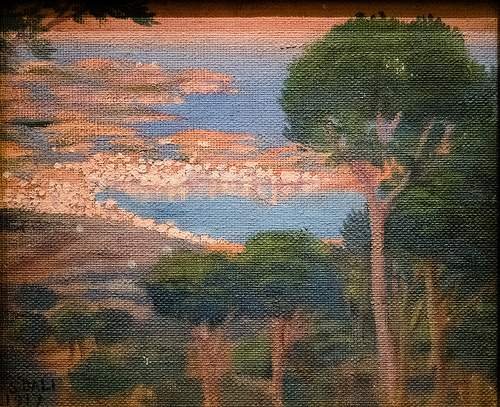Exploring Salvador Dalí’s Strange and Surreal ‘Persistence of Memory’

Salvador Dalí, “The Persistence of Memory,” 1931
With its strange subject matter and dream-like atmosphere, Salvador Dalí‘s painting, The Persistence of Memory, has become a well-known symbol of Surrealism. Painted during the Dada-inspired movement,
the melting-clocks-masterpiece embodies the sensibilities that define the experimental and eccentric genre.
To contextualize the iconic piece’s place in art history, one must understand its unique influences, examine its symbolic content, and appreciate the artist’s avant-garde approach to its creation.
The Persistence of Memory was painted in 1931, at the height of the Surrealist Movement. During this time, innovative artists explored ideas of automatism and the self-conscious in their work. This experimental approach to art culminated in a tendency toward peculiar subject matter that evokes dreams and challenges perceptions.

Salvador Dalí and Man Ray in Paris, 1934. (Photo: Carl Van Vechten / Library of Congress)
As a key figure of the movement, Salvador Dalí delved deep into this artistic mindset, which he viewed as revolutionary and liberating. “Surrealism is destructive,” he explained, “but it destroys only what it considers to be shackles limiting our vision.”
When Dalí painted The Persistence of Memory, his artistic practice was guided by the peculiar “paranoiac-critical method.” Developed by the artist in 1930, the technique relies on self-induced paranoia and hallucinations to facilitate a work of art. This method was particularly instrumental in the creation of Dalí’s “hand-painted dream photographs,” a collection of works that are stylistically rooted in realism yet unrealistic in subject matter.
Surrealist Symbolism
Though set in a realistically-rendered landscape, The Persistence of Memory features bizarre subject matter evocative of a dream. While the actual inspiration behind the scene is up for debate (art historians recall Einstein’s theory; Dalí comically mentioned Camembert cheese), the odd iconography of the painting is characteristic of the Surrealist movement.

MELTING CLOCKS
A set of melting clocks—or “soft watches,” as many Surrealists have called them—are scattered across the composition. These fascinating timepieces appear to have lost their integrity, as they’re limply draped over a tree branch or sliding off of an ambiguous platform. A single pocket watch, which remains closed, retains its structure, though an army of ants ominously cover its case.
ANTHROPOMORPHIC FORM
Perhaps the most perplexing part of the scene is an anthropomorphic mass sprawled on the ground. This face-like figure is thought to be a self-portrait of the artist. This interpretation is fitting, as Dalí is known for both his unconventional self-portrayals, like Soft Self-Portrait With Grilled Bacon, and his one-of-a-kind depictions of not-quite-human faces, like the figure in his painting, Sleep.
“Soft Self-Portrait With Grilled Bacon,” 1941

FAMILIAR LANDSCAPE
While the rocky landscape in the painting’s background may look like any ambiguous natural formation, it is actually inspired by Dalí’s native Catalonia. Specifically, the coastal cliffs represent Cap de Creus, a peninsula close to the artist’s home.

Additionally, the triangular shadow that appears to crawl across the canvas is believed to be cast by Mount Pani, a mountain near the Dalí family’s beloved summer home. A reference to this peak has also popped up in View of Cadaqués with Shadow of Mount Paní, an early Dalí painting that depicts an idyllic Mediterranean town from Mount Pani’s summit.
(https://mymodernmet.com/the-persistence-of-memory-salvador-dali/)
Posted using Partiko Android
Warning! This user is on my black list, likely as a known plagiarist, spammer or ID thief. Please be cautious with this post!
our discord. If you believe this is an error, please chat with us in the #cheetah-appeals channel in